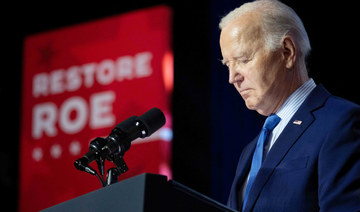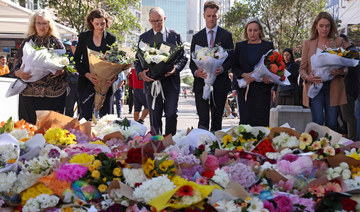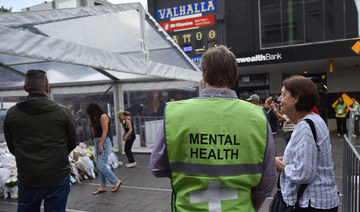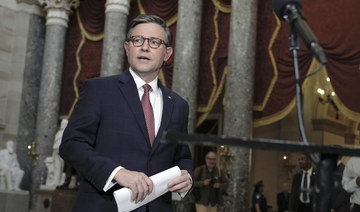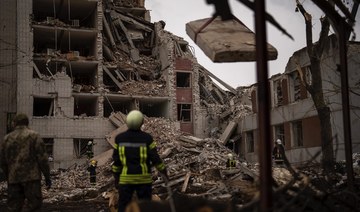DETROIT: US safety regulators have pressured Tesla into recalling nearly 363,000 vehicles with its “Full Self-Driving” system because it misbehaves around intersections and doesn’t always follow speed limits.
The recall, part of part of a larger investigation by the National Highway Traffic Safety Administration into Tesla’s automated driving systems, is the most serious action taken yet against the electric vehicle maker.
It raises questions about CEO Elon Musk’s claims that he can prove to regulators that cars equipped with “Full Self-Driving” are safer than humans, and that humans almost never have to touch the controls.
Musk at one point had promised that a fleet of autonomous robotaxis would be in use in 2020. The latest action appears to push that development further into the future.
The safety agency says in documents posted on its website Thursday that Tesla will fix the concerns with an online software update in the coming weeks. The documents say Tesla is doing the recall but does not agree with an agency analysis of the problem.
The system, which is being tested on public roads by as many as 400,000 Tesla owners, makes unsafe actions such as traveling straight through an intersection while in a turn-only lane, failing to come to a complete stop at stop signs, or going through an intersection during a yellow traffic light without proper caution, NHTSA said.
In addition, the system may not adequately respond to changes in posted speed limits, or it may not account for the driver’s adjustments in speed, the documents said.
“FSD beta software that allows a vehicle to exceed speed limits or travel through intersections in an unlawful or unpredictable manner increases the risk of a crash,” the agency said in documents.
Musk complained Thursday on Twitter, which he now owns, that calling an over-the-air software update a recall is “anachronistic and just flat wrong!” A message was left Thursday seeking further comment from Tesla, which has disbanded its media relations department.
Tesla has received 18 warranty claims that could be caused by the software from May of 2019 through Sept. 12, 2022, the documents said. But the Austin, Texas, electric vehicle maker told the agency it is not aware of any deaths or injuries.
In a statement, NHTSA said it found the problems during tests performed as part of an investigation into Tesla’s “Full Self-Driving” and “Autopilot” software that take on some driving tasks. The investigation remains open, and the recall doesn’t address the full scope of what NHTSA is scrutinizing, the agency said.
Despite the names “Full Self-Driving” and “Autopilot,” Tesla says on its website that the cars cannot drive themselves and owners must be ready to intervene at all times.
NHTSA’s testing found that Tesla’s FSD beta testing, “led to an unreasonable risk to motor vehicle safety based on insufficient adherence to traffic safety laws.”
Raj Rajkumar, a professor of computer engineering at Carnegie Mellon University, doubts that Tesla can fix the problems cited by NHTSA with a software update. The automaker, he says, relies only on cameras and artificial intellingence to make driving decisions, a system that will make mistakes.
“Cameras can miss a lot of things,” Rajkumar said. “These are not straightforward issues to fix. If they could have fixed it, they would have fixed it a long time back.”
Most other companies with self-driving vehicles use laser sensors and radar in addition to cameras to make sure vehicles see everything. “One sensing modality is not perfect by any metric,” Rajkumar said.
He questioned whether NHTSA will require testing before the software update is sent out to make sure it works. The agency said that it works closely with automakers as they develop recall remedies “to ensure adequacy.”
In documents, NHTSA says that on Jan. 25, as part of regular communications with Tesla, it told the automaker about concerns with FSD, and it asked Tesla to do a recall. On Feb. 7, Tesla decided to do the recall out of an abundance of caution, “while not concurring with the agency’s analysis.”
The recall is another in a list of problems that Tesla has with the US government. In January, the company disclosed that the US Justice Department had requested documents from Tesla about “Full Self-Driving” and “Autopilot.”
NHTSA has been investigating Tesla’s automated systems since June of 2016 when a driver using Autopilot was killed after his Tesla went under a tractor-trailer crossing its path in Florida. A separate probe into Teslas that were using Autopilot when they crashed into emergency vehicles started in August 2021. At least 14 Teslas have crashed into emergency vehicles while using the Autopilot system.
NHTSA has sent investigators to 35 Tesla crashes in which automated systems are suspected of being used. Nineteen people have died in those crashes, including two motorcyclists.
The agency also is investigating complaints that Teslas can brake suddenly for no reason.
Since January of 2022, Tesla has issued 20 recalls, including several that were required by NHTSA. The recalls include one from January of last year for “Full Self-Driving” vehicles being programmed to run stop signs at slow speeds.
“Full Self-Driving” went on sale late in 2015, and Musk has used the name ever since. It currently costs $15,000 to activate the system.
The recall announced Thursday covers certain 2016-2023 Model S and Model X vehicles, as well as 2017 through 2013 Model 3s, and 2020 through 2023 Model Y vehicles equipped with the software, or with installation pending.
Shares of Tesla closed Thursday down 5.7 percent. The stock has rallied about 64 percent in the year to date, reversing 2022’s hefty loss.
Tesla recalls ‘Full Self-Driving’ to fix unsafe actions
https://arab.news/ytvdx
Tesla recalls ‘Full Self-Driving’ to fix unsafe actions
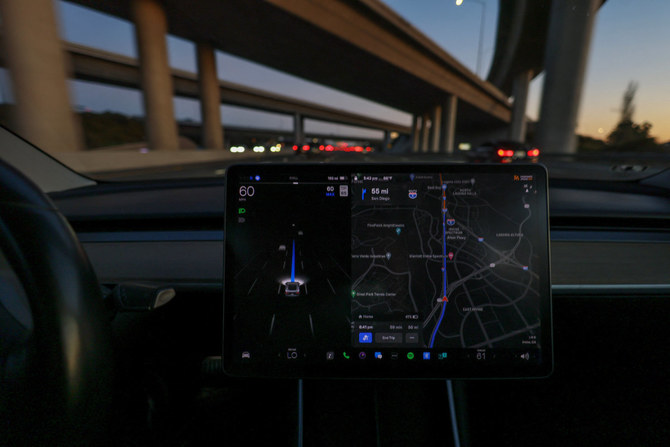
- Tesla CEO Elon Musk had claimed that cars equipped with “Full Self-Driving” are safer than humans
- But US safety regulators say the system misbehaves around intersections and doesn’t always follow speed limits
Over 100 pro-Palestinian protesters arrested from New York's Columbia campus
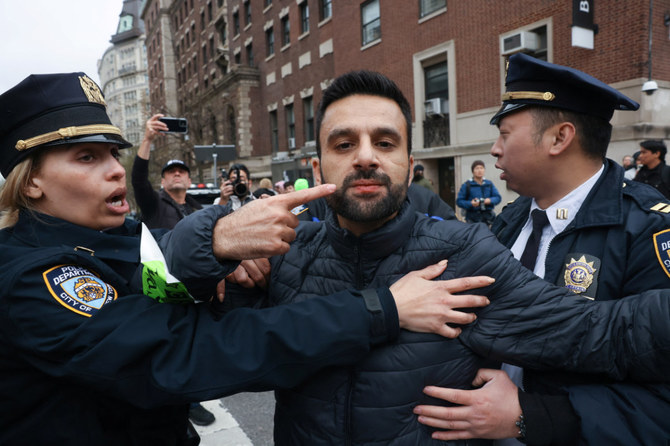
- University President Nemat Minouche Shafik said she authorized police to remove tents set up by protesters for the safety of the campus
- Protesters clashed with police, bringing back memories of the demonstrations against the Vietnam War at Columbia more than 50 years ago
More than 100 pro-Palestinian protesters were arrested on Wednesday on the campus of Columbia University after its president authorized New York police to clear an encampment set up by students demonstrating against Israel’s actions in Gaza.
Columbia University President Nemat Minouche Shafik, who a day earlier came under fire from Republicans at a House of Representatives committee hearing on antisemitism on campus, said she had authorized police to clear an encampment of dozens of tents set up by protesters on Wednesday morning.
“Out of an abundance of concern for the safety of Columbia’s campus, I authorized the New York Police Department to begin clearing the encampment ... ” Shafik said in a statement.
Shafik said the protesters had violated the school’s rules and policies against holding unauthorized demonstrations, and were not willing to engage with administrators.
New York City Mayor Eric Adams said police made over 108 arrests, adding “there was no violence or injuries during the disturbance.” Adams added students had the right to free speech but not the right to violate university policies. Police officials said the arrests were related to trespassing.
Columbia said it had started to suspend students who had participated in the tent encampment, which the school considers an unauthorized protest.
“We are continuing to identify them and will be sending out formal notifications,” a spokesperson of the university said in an email.
At least three students have already received suspension notices from Barnard College, an affiliate of Columbia, for participating in the encampment, Institute for Middle East Understanding, a pro-Palestinian advocacy group, said.
The three students were Isra Hirsi, Maryam Iqbal, and Soph Dinu, the institute said. Hirsi is the daughter of US Representative Ilhan Omar, who had expressed support for protesters during the hearing at which Shafik testified on Wednesday.
“Those of us in Gaza solidarity encampment will not be intimidated,” Hirsi said on social media after being suspended.
The clash, reminiscent of the demonstrations against the Vietnam War at Columbia more than 50 years ago, is the latest in a series of demonstrations on US university campuses since the latest escalation of the Israeli-Palestinian conflict began on Oct. 7. Anti-war protests have been staged near airports and on bridges in New York, Los Angeles and other cities, while vigils and marches have taken place in Washington and elsewhere.
Alongside the proliferations of protests, human rights advocates have also pointed to a rise in bias and hate against Jews, Arabs and Muslims in recent months.
The congressional committee on Wednesday accused Shafik of failing to protect Jewish students on campus, echoing accusations leveled against three other elite university leaders at a hearing last year that sent shockwaves through higher education.
She responded by saying the university was facing a “moral crisis” with antisemitism on campus, and Columbia had taken strong actions against suspected perpetrators.
Protesters at Columbia have demanded a permanent ceasefire in the Gaza enclave and an end to US military assistance for Israel, as well as divestment by the university from companies that profit from Israel’s incursion into Gaza.
The encampment was organized by a student-led coalition of groups, including Columbia University Apartheid Divest, Students for Justice in Palestine, and Jewish Voice for Peace.
Separately on Thursday, a march was also planned at the University of Southern California in support of Asna Tabassum, a Muslim student whose valedictorian speech was canceled by the university, which cited safety concerns.
Tabassum and her supporters say the university sought to silence her because of her opposition to the Israeli assault on Gaza, which has killed over 33,000 people, according to the Gazan health ministry, and displaced nearly all its 2.3 million population.
Israel’s assault was triggered by the Oct. 7 cross-border attack by Hamas militants that killed 1,200 people, according to Israeli tallies.
Teenager charged with terrorism over stabbing attack on TikToker Sydney bishop

- Police said the boy had traveled for 90 minutes to reach the church from his home and stabbed Bishop Mar Mari Emmanuel at least six times
- The 53-year-old Assyrian Church bishop has a popular youth following on TikTok and has been a target of criticism, hate and online trolling
SYDNEY, Australia: A 16-year-old boy has been charged with a terrorism offense for allegedly stabbing an Assyrian church bishop in Sydney during a church service, Australian police said on Friday, as investigations continued into a riot after the knife attack.
Police from the joint counter-terrorism team questioned the boy, who is in a hospital under police guard recovering from injuries, on Thursday and charged him with committing a terrorist act. If convicted, he could get a maximum penalty of imprisonment for life.
He has been refused bail and is expected to appear before a bedside court hearing on Friday, New South Wales state Police Commissioner Karen Webb said during a press conference.
Police will allege the bishop was stabbed as many as six times and that the boy had traveled for 90 minutes to reach the church from his home, Webb said.
A riot broke out outside the church soon after the attack on Bishop Mar Mari Emmanuel after an angry crowd demanded the suspected attacker be handed over to them. More than 50 police officers were injured and 20 police cars were damaged.
The 53-year-old bishop has a popular youth following on TikTok and has been a target of criticism, hate and online trolling. His sermons range from homilies on the Bible to fiery criticisms of homosexuality, COVID-19 vaccinations, Islam and the election of US President Joe Biden.
Bishop Emmanuel, in an audio message on social media on Thursday, said he had forgiven his attacker and that he was recovering quickly.
Two knife attacks within three days — at a mall near Bondi beach that killed six people on Saturday and at the Assyrian Christ The Good Shepherd Church in Sydney’s west on Monday — have shocked residents of Australia’s most populous city.
The incidents have sparked calls for greater public security in Australia, where gun crimes and knife attacks are rare due to tough laws.
The shopping center will reopen for business on Friday, while a candlelight vigil will be held on Sunday to mourn the victims. The attacker, 40-year-old Joel Cauchi, was shot to death by police inside the mall.
Ukraine seeks urgent G7, NATO help for battered air defenses

- NATO chief says working on a solution
- UK seeks ‘creative’ deal on seized Russian assets
CAPRI, Italy: Ukraine warned foreign ministers from the Group of Seven (G7) major powers on Thursday they had to change strategy if they wanted Kyiv to withstand increasingly destructive Russian air assaults.
The G7 ministers meeting on the island of Capri acknowledged the need to get more air defense systems to Ukraine and applauded Ukrainian Foreign Minister Dmytro Kuleba as he joined them on the second day of their three-day gathering.
The G7, comprising Italy, Canada, France, Germany, Japan, Britain, the United States and European Union representatives, has been fiercely critical of Russia’s two-year long invasion of Ukraine.
However, military aid to Kyiv has slowed in recent months, with European partners apparently running low on ammunition and vital US funding blocked by Republicans in Congress.
Speaking to reporters as he arrived in Capri, Kuleba bemoaned the fact that while US, British and French forces had intervened on Saturday to help prevent Iranian missiles from hitting Israel, his own country lacked vital defenses.
“The strategy of our partners in Israel seems to be in preventing damage and death. ... In the last months, the strategy of our partners in Ukraine seems to be in helping (us) to recover from damage,” he said.
“So our job today is to find a way where our partners will design a mechanism, a way that will allow us also to avoid death and destruction in Ukraine.”
NATO Secretary General Jens Stoltenberg also took part in Thursday’s G7 meetings, telling reporters beforehand that the military alliance was actively seeking to send more air defense systems as quickly as possible.
“We are working at the possibility of (dispatching) more Patriot batteries to Ukraine. We are in dialogue with some specific countries,” he said.
In Washington, Ukrainian Prime Minister Denys Shmyhal told reporters that Ukraine had asked for additional air defense equipment and another Patriot missile battery, adding that Kyiv was looking for a minimum of seven Patriot systems.
Shmyhal declined to say how many Patriot systems Ukraine had currently, saying that was classified information.
He said US and White House officials had assured the Ukrainian delegation that weapons would be supplied in a matter of weeks, not months, once a $60.8 billion US aid package for Ukraine was approved by Congress.
“We hope it will take days, but not more than weeks,” he said.
Domestic political wrangling has delayed delivery of the US aid, but the US House of Representatives might finally get to vote on the package this weekend, bringing some hope to G7 ministers.
Looking to Washington
Germany has already said it would hand over one Patriot system. European Union foreign policy chief Josep Borrell urged other EU nations to do likewise to help stave off concerted Russian attacks on vital Ukrainian infrastructure.
“Otherwise the electricity system of Ukraine will be destroyed. And no country can fight without having electricity at home, in the factories, online, for everything,” he told reporters in Capri.
“In these turbulent times, it is a hopeful sign that there are now signals from the Republicans in the US that support for Ukraine can be continued intensively,” German Foreign Minister Annalena Baerbock told a news conference.
Another key issue under review is how to use profits from some $300 billion of sovereign Russian assets held in the West to help Ukraine, as European Union member states hesitate over concerns about the legality of such a move.
“It’s important we try and get agreement. ... That’s what we’re discussing here. I’m in no doubt we will find a way, but we’re going to have to be creative. We’ll have to be flexible,” said British Foreign Secretary David Cameron.
Shmyhal told reporters in Washington that he had detailed discussions with US and G7 officials about how to use the frozen Russian assets, and he expected some results on that front this year.
Kuleba said he hoped to get immediate pledges this week on the delivery of more Patriot and SAMP/T air defense systems and also new Western sanctions targeting Iran’s production of armed drones, which are being exported to Russia.
Hours later, the United States and Britain announced they would introduce new sanctions on Iran targeting its drone program in retaliation for the April 13 strike on Israel.
But some G7 ministers also urged Israel not to exacerbate an already tense situation with a major retaliation of its own.
“Our appeal is always for prudence and de-escalation,” said Italian Foreign Minister Antonio Tajani. “We hope that Israel’s response, which will probably come, will be a targeted response and not something that provokes escalation.”
Germany holds 2 over military base attack plot for Russia
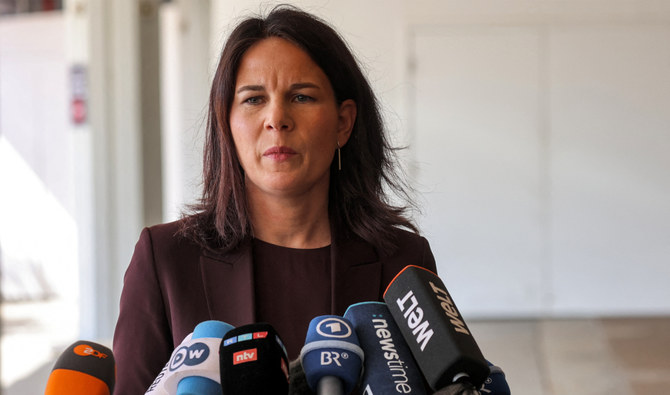
- NATO working on more air defenses for Ukraine, Stoltenberg says
BERLIN: Two German Russian nationals have been arrested in Germany on suspicion of plotting sabotage attacks, including on US military facilities, in what officials called a serious effort to undermine military support for Ukraine.
Authorities have searched the homes and workplaces of the two suspects who stand accused of working for a foreign secret service. One of them, identified as Dieter S., had since October 2023 discussed possible plots with a person linked to the Russian secret service, prosecutors said on Thursday.
Germany has become one of Kyiv’s biggest suppliers of military aid since Russian President Vladimir Putin ordered a full-scale invasion of Ukraine in February 2022, and is a major target for Russian spying operations, authorities have said.
“The suspicion that Putin is recruiting agents from us to carry out attacks on German soil is extremely serious. We will not allow Putin to bring his terror to Germany,” Foreign Minister Annalena Baerbock said.
Germany summoned the Russian ambassador over the arrests. Earlier, the Kremlin said it had no information about the issue.
Dieter S. had been prepared to carry out bomb and arson attacks on military facilities, including those operated by US forces, prosecutors said, adding that he took photos and videos of military transport and equipment.
A second person, Alexander J., began helping him from March at the latest, prosecutors said.
According to Spiegel magazine, the facilities included the Grafenwoehr army base in the southern state of Bavaria where Ukrainian soldiers receive training to use US Abrams tanks.
US, allied and partner training missions at Grafenwoehr, including the training of Ukrainians, continue, a US military spokesperson said, but referred inquiries about the arrests to the German authorities.
The prosecutors suspect Dieter S., whose last name has not been disclosed due to German privacy laws, was a fighter for Russian-backed forces in eastern Ukraine from December 2014 to September 2016 in the self-proclaimed Donetsk People’s Republic.
He was in possession of a firearm, prosecutors said.
In a separate case, prosecutors last month charged an officer in Germany’s military procurement agency with attempting to pass secret information to Russian intelligence. News of Thursday’s arrests coincided with a surprise trip by German Economy Minister Robert Habeck to Ukraine.
Germany also issued an urgent appeal this week for countries to help shore up Ukraine’s air defenses as Russian forces continue to pound Ukrainian cities and infrastructure.
“We will continue to provide massive support to Ukraine and will not allow ourselves to be intimidated,” Interior Minister Nancy Faeser said.
Meanwhile, NATO is working to send more air defense systems to Ukraine, Secretary-General Jens Stoltenberg said, adding that delays in providing such aid were harming Kyiv’s efforts to resist Russia’s attacks.
“We have compiled data about the different air defense systems we have in NATO and focused on the Patriot systems. And we are working with allies to ensure that they redeploy some of their systems to Ukraine,” he said in Italy.
Cameron tells Netanyahu UK will not ban IRGC: Report
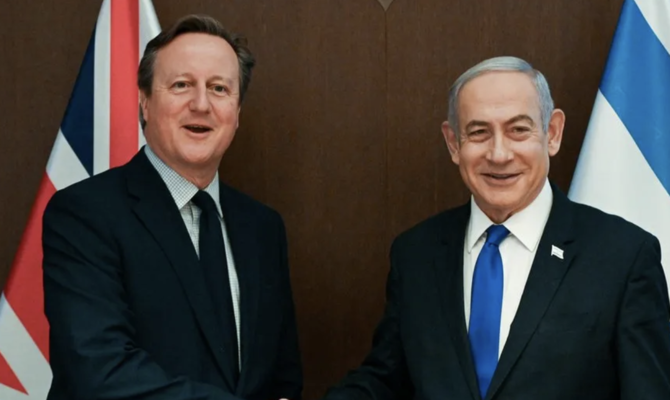
- Stance relayed during face-to-face talks between British FM, Israeli PM Wednesday
- ‘We need to be able to pick up the phone. If we proscribed them it would not help the situation’
LONDON: The UK will not proscribe Iran’s Islamic Revolutionary Guard Corps as a terrorist organization, the Daily Telegraph reported on Thursday.
The stance was reportedly relayed by UK Foreign Secretary David Cameron during a face-to-face meeting with Israeli Prime Minister Benjamin Netanyahu and Foreign Minister Israel Katz on Wednesday.
The Israeli government reportedly requested that the UK ban the IRGC following Iran’s drone and missile attack last week.
But Cameron, in what a source called a “blunt” response, told Netanyahu and Katz that doing so would hinder London’s ability to communicate with Tehran.
“We need to be able to pick up the phone. If we proscribed them it would not help the situation,” the source reported Cameron as saying.
If the IRGC were to be proscribed in the UK, it would make membership of it, attending its meetings, displaying its symbols or campaigning for it in the country illegal.
The move has been considered by the UK government for over a year, but Home Office officials have long warned that doing so would sever one of the few remaining diplomatic channels with Tehran. Instead, the IRGC has been sanctioned by the UK government on several occasions.
The US, which has banned the IRGC, has also suggested that the UK should proscribe it. The group’s navy was recently included in a new set of joint sanctions issued by London and Washington.






